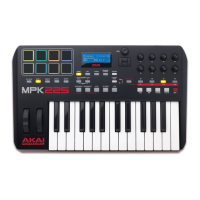
Do you have a question about the Akai MPK225 and is the answer not in the manual?
| Mixer section | - |
|---|---|
| Product color | Black |
| Built-in display | Yes |
| Power supply type | USB |
| Minimum RAM | 1 GB |
| Minimum processor | Pentium 4/Celeron/G4/G5 or faster |
| Minimum processor speed | 1.5 GHz |
| Mac operating systems supported | Mac OS X 10.4 Tiger, Mac OS X 10.5 Leopard, Mac OS X 10.6 Snow Leopard, Mac OS X 10.7 Lion, Mac OS X 10.8 Mountain Lion, Mac OS X 10.9 Mavericks |
| Windows operating systems supported | Windows 7 Home Basic, Windows 8, Windows Vista Business, Windows XP Home |
| Bundled software | Ableton Live Lite, Hybrid 3 by AIR Music Tech, SONiVOX Twist 2.0 & Akai Pro MPC Essentials (downloads) |
| Depth | 92 mm |
|---|---|
| Width | 489 mm |
| Height | 298 mm |
| Weight | 2760 g |
Specific instructions for connecting the MPK225 to Mac OS X systems.
Explains how to use the MPK225 with external MIDI modules or iOS devices.
Introduces Preset Mode for loading, saving, and managing configurations.
Introduces Edit Mode for customizing device parameters.
Introduces Global Mode for system-wide settings and preferences.
Introduces Program Change Mode for sending MIDI program change messages.
Step-by-step guide on how to load a preset configuration.
Instructions for saving current settings or copying them to a new preset number.
Procedure to revert all presets to their original factory default settings.
Configures MIDI channel, octave offset, and note transposition for the keyboard.
Controls MIDI output routing and enables/disables Aftertouch messages.
Sets the tempo in BPM and the time division for rhythmic functions.
Adjusts the keyboard's response to playing velocity globally.
Sets the global tempo and tap tempo averaging.
Details the 25-note velocity-sensitive keyboard and octave adjustment buttons.
Describes the functionality and types of assignable knobs and switches.
Explains the Loop function and dedicated transport control buttons.
Explains the USB port for data/power and the MIDI Out port.
Describes the MIDI In port for receiving MIDI messages.
Lists and explains parameters for the Keyboard in Edit Mode.
Lists and explains parameters for Assignable Pads in Edit Mode.
Lists parameters for Pads in Program Change and Bank modes.
Lists and explains parameters for Assignable Knobs in Edit Mode.
Lists and explains parameters for Assignable Switches in Edit Mode.